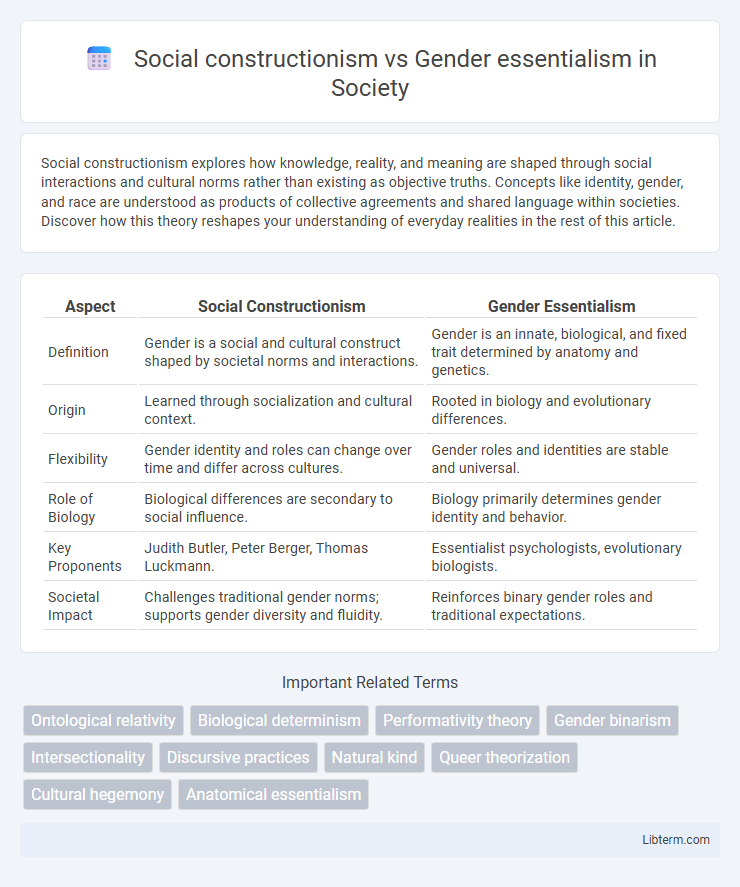Social constructionism explores how knowledge, reality, and meaning are shaped through social interactions and cultural norms rather than existing as objective truths. Concepts like identity, gender, and race are understood as products of collective agreements and shared language within societies. Discover how this theory reshapes your understanding of everyday realities in the rest of this article.
Table of Comparison
| Aspect | Social Constructionism | Gender Essentialism |
|---|---|---|
| Definition | Gender is a social and cultural construct shaped by societal norms and interactions. | Gender is an innate, biological, and fixed trait determined by anatomy and genetics. |
| Origin | Learned through socialization and cultural context. | Rooted in biology and evolutionary differences. |
| Flexibility | Gender identity and roles can change over time and differ across cultures. | Gender roles and identities are stable and universal. |
| Role of Biology | Biological differences are secondary to social influence. | Biology primarily determines gender identity and behavior. |
| Key Proponents | Judith Butler, Peter Berger, Thomas Luckmann. | Essentialist psychologists, evolutionary biologists. |
| Societal Impact | Challenges traditional gender norms; supports gender diversity and fluidity. | Reinforces binary gender roles and traditional expectations. |
Understanding Social Constructionism
Social constructionism asserts that gender is a fluid and culturally shaped concept rather than a fixed biological trait, emphasizing how societal norms and language shape individual identity and roles. Research in sociology and psychology highlights how institutions, media, and interpersonal interactions construct and reinforce gender categories, making them contingent rather than innate. Understanding this framework allows for a critical examination of how power dynamics and historical contexts influence gender perceptions and experiences across different cultures.
Defining Gender Essentialism
Gender essentialism defines gender as a fixed, innate characteristic determined by biological sex, asserting that male and female traits are natural and unchangeable. This perspective emphasizes inherent differences in abilities, behaviors, and roles between men and women based on genetic or hormonal factors. Critics argue that gender essentialism overlooks social, cultural, and historical influences shaping gender identity and expression.
Historical Origins of Both Perspectives
Social constructionism emerged in the mid-20th century, influenced by sociologists like Peter Berger and Thomas Luckmann who emphasized the role of social interactions in shaping reality. Gender essentialism roots trace back to ancient philosophical traditions, such as Aristotle's biological determinism, which viewed gender differences as natural and immutable. The historical development of these perspectives reflects a shift from fixed, biology-based interpretations to dynamic, culturally influenced understandings of gender.
Key Theoretical Concepts
Social constructionism posits that gender identities and roles are created and maintained through social interactions, language, and cultural norms, emphasizing the fluidity and variability of gender across different societies and historical periods. Gender essentialism argues that gender differences are innate, biologically determined, and fixed, based on inherent characteristics linked to sex. Key theoretical concepts in social constructionism include performativity, social scripts, and discourse analysis, while gender essentialism relies on biological determinism and evolutionary psychology frameworks.
Social Constructionism in Gender Identity
Social constructionism in gender identity posits that gender roles and expectations are created through cultural, social, and historical contexts rather than being innate or biologically determined. This perspective emphasizes how language, norms, and social interactions shape individuals' understanding and expression of gender beyond binary classifications. Research highlights that gender identity is fluid and varies across different societies, demonstrating the impact of social constructs in defining gender experiences.
The Role of Biology in Gender Essentialism
Gender essentialism asserts that biological factors such as chromosomes, hormones, and brain structures fundamentally determine gender identity and roles, emphasizing innate and immutable differences between males and females. This perspective views biological sex as the primary source of gender characteristics, often relying on scientific findings related to genetics and endocrinology to support essentialist claims. Critics argue that this biological determinism overlooks the influence of cultural, social, and environmental factors that social constructionism highlights in shaping gender expressions.
Critiques of Social Constructionism
Critiques of social constructionism highlight its tendency to downplay biological and innate factors in shaping gender identity, potentially oversimplifying the complex interplay between nature and nurture. Critics argue that this perspective may neglect essential psychological and physiological elements that contribute to gender differences, leading to an incomplete understanding. Furthermore, some claim social constructionism's emphasis on cultural variability risks undermining the significance of universal gender traits observed across diverse societies.
Critiques of Gender Essentialism
Gender essentialism faces strong critiques for oversimplifying complex gender identities by attributing fixed, biologically determined traits to men and women, which ignores cultural and individual variability. Social constructionists argue that gender is fluid, shaped by social, historical, and linguistic contexts rather than innate characteristics. This critique emphasizes the exclusion and marginalization of non-binary and transgender experiences inherent in essentialist frameworks.
Implications for Gender Equality and Policy
Social constructionism views gender as a fluid and culturally shaped identity, promoting policies that accommodate diverse gender expressions and challenge traditional roles, thus fostering inclusivity and equality. Gender essentialism, which posits inherent and immutable differences between sexes, often reinforces binary norms and limits policy approaches to gender equality by emphasizing biological determinism. Embracing social constructionist perspectives in policy development can lead to more equitable frameworks that address discrimination and support gender diversity in education, workplace, and legal systems.
Bridging the Divide: Contemporary Perspectives
Contemporary perspectives on social constructionism and gender essentialism emphasize the fluidity of gender identities shaped by cultural, social, and historical contexts versus innate, biologically determined traits. Bridging this divide involves recognizing the interplay between biological factors and sociocultural influences, fostering more inclusive frameworks that accommodate diverse gender expressions. Recent scholarship advocates for integrative approaches combining insights from neuroscience, psychology, and feminist theory to enrich understanding and challenge binary gender norms.
Social constructionism Infographic

 libterm.com
libterm.com